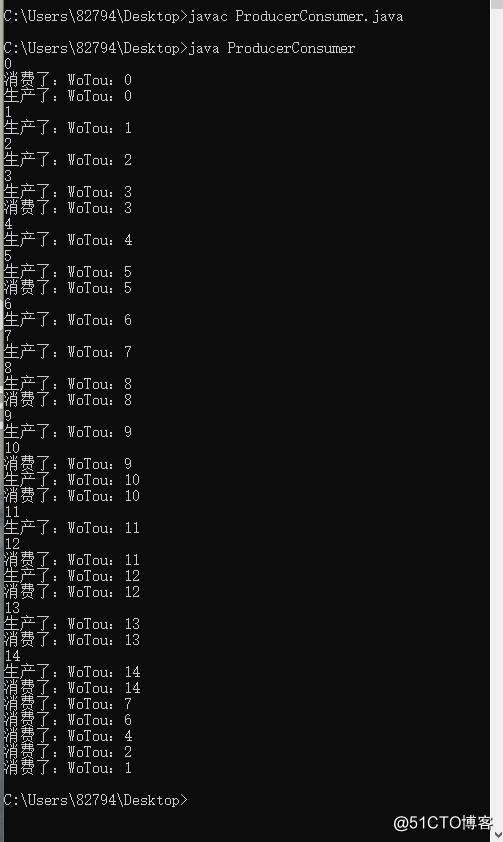标签:定义 run class 时间 ESS star err 需要 tst
1. 前言 生产者-消费者问题是经典的线程同步问题(我会用java和c分别实现),主要牵扯到三个点:
一:能否互斥访问共享资源(不能同时访问共享数据);
二:当公共容器满时,生产者能否继续生产(生产者应阻塞并唤醒消费者消费);
三:当公共容器为空时,消费者能否继续消费(消费者应阻塞并唤醒生产者生产)。
step0:在java中我们创建线程是通过继承Thread类或者继承Runnable接口并实现他的run方法来实现的,这里我们采用后者
step1:定义一个放馒头的大筐(一个公共的容器类),这个筐具有push方法和pop方法,分别对应往筐中放馒头和从筐中取出馒头。由于在同一个时间段内只能有一个线程访问此方法,so,我们给这两个方法加锁。代码如下:
class SyncStack{//定义放馒头的筐,是栈,先进后出
int index = 0;//定义筐里面馒头的编号
WoTou[] arrWT = new WoTou[6];//定义一个引用类型的数组
public synchronized void push(WoTou wt){//定义往筐里放馒头的方法,由于需要保证在一段特定时间里只能有一个线程访问此方法,所以用synchronized关键字
while(index == arrWT.length){
try{
this.wait();
}catch(InterruptedException e){
e.printStackTrace();
}
}
this.notify();
arrWT[index] = wt;
index ++;
}
public synchronized WoTou pop(){//定义从筐里往外拿馒头的方法,同理在一段时间只能有一个线程访问此方法,所以用synchronized关键字
while(index == 0){
try{
this.wait();//当前的正在我这个对象访问的这个线程wait
}catch(InterruptedException e){
e.printStackTrace();
}
}
this.notify();//唤醒一个等待的线程,叫醒一个正在wait在我这个对象上的线程
index --;
return arrWT[index];
}
}step2:分别定义生产者和消费者的类,他们均是不同的线程。给出代码:
class Producer implements Runnable{//定义生产者这个类,是一个线程
SyncStack ss = null;//声明了筐子的引用变量ss,表示做馒头的人往那个筐里放馒头
Producer(SyncStack ss){
this.ss = ss;
}
public void run(){
for(int i=0; i<20; i++){
WoTou wt = new WoTou(i);//new出一个馒头,该馒头的编号为i
ss.push(wt);//把第i个馒头放到筐中
System.out.println(i);
System.out.println("生产了:" + wt);
try{
Thread.sleep((int)(Math.random() * 200));//每生产一个睡眠1s
}catch (InterruptedException e){
e.printStackTrace();
}
}
}
}
class Consumer implements Runnable{//定义消费者这个类,也是一个线程
SyncStack ss = null;//声明了筐子的引用变量ss,表示吃馒头的人往那个筐里拿馒头
Consumer(SyncStack ss){
this.ss = ss;
}
public void run(){
for(int i=0; i<20; i++){
WoTou wt = ss.pop();//取出一个馒头
System.out.println("消费了:" + wt);//开始吃馒头
try{
Thread.sleep((int)(Math.random() * 1000));
//每消费一个睡眠1s
}catch (InterruptedException e){
e.printStackTrace();
}
}
}
}step3:我们事先定义了一个馒头类,现在给出测试类测试:
/*
wait和sleep的区别
-1:sleep不需要唤醒,线程不会释放对象锁,属于Thread类
-2:wait需要notify()方法唤醒,线程会放弃对象锁,属于Object类
*/
public class ProducerConsumer{
public static void main(String[] args){
SyncStack ss = new SyncStack();
Producer p = new Producer(ss);
Consumer c = new Consumer(ss);
new Thread(p).start();
new Thread(c).start();
}
}
class WoTou{//定义馒头这个类
int id;//定义馒头的编号
WoTou(int id){
this.id = id;
}
public String toString(){//重写toString方法
return "WoTou:" + id;
}
} step4:看下测试结果,发现符合我们事先说的那三点:
step0:c语言在Windows下实现线程的需要导入#include<process.h>头文件,用_beginthread();来开始一个线程,用_endthread();来结束一个线程。具体操作方法,自行百度。
step1:C语言中缓冲区对应公共容器,我们通过定义互斥信号量mutex来实现线程对缓冲池的互斥访问。直接看下代码操作:
#include<stdio.h>
#include<process.h>
#define N 10
//代表执行生产和消费的变量
int in=0, out=0;
//线程结束的标志
int flg_pro=0, flg_con=0;
//mutex:互斥信号量,实现线程对缓冲池的互斥访问;
//empty和full:资源信号量,分别表示缓冲池中空缓冲池和满缓冲池的数量(注意初值,从生产者的角度)
int mutex=1, empty=N, full=0;
//打印测试
void print(char c){
printf("%c 一共生产了%d个窝头,消费了%d个窝头,现在有%d个窝头\n", c, in, out, full);
}
//请求某个资源
void wait(int *x){
while((*x)<=0);
(*x)--;
}
//释放某个资源
void signal(int *x){
(*x)++;
}
//生产者
void produce(void *a){
while(1){
// printf("开始阻塞生产者\n");
wait(&empty); //申请一个缓冲区,看有无其他线程访问
wait(&mutex);
// printf("结束阻塞生产者\n");
in++;
signal(&mutex);
signal(&full); //full加一,唤醒消费者,告诉消费者可以消费
// printf("生产者执行。。。\n");
print(‘p‘);
Sleep(200);
if(flg_pro == 1){
_endthread();
}
}
}
//消费者
void consumer(void * a){
while(1){
// printf("开始阻塞消费者\n");
wait(&full);
wait(&mutex);
// printf("结束阻塞消费者\n");
out++;
signal(&mutex);
signal(&empty);
// printf("消费者执行。。。\n");
print(‘c‘);
Sleep(200);
if(flg_con == 1){
_endthread();
}
}
}
//主函数
int main(){
_beginthread(consumer,0,NULL);
_beginthread(produce,0,NULL);
//总的执行时间为1分钟
Sleep(10000);
flg_pro=flg_con=1;
system("pause");
return 0;
} step2:注意事项:
1)用来实现互斥的wait(&mutex);和signal(&mutex);必须成对出现在每一个线程中,对于资源信号量的wait和signal操作,分别成对出现在不同的线程中
2)先执行对资源信号量的wait操作,在执行对互斥信号量的wait操作,不能颠倒否则导致死锁。
step3:测试结果,符合预期:
现在缺乏的是一种把生活中具体的问题抽象成代码的能力,可能也是对c语言的不熟悉导致的问题,看着我宿舍大神写的代码,真漂亮,由衷的羡慕。熟知并非真知,还得多加思考才是。
标签:定义 run class 时间 ESS star err 需要 tst
原文地址:http://blog.51cto.com/13416247/2173951